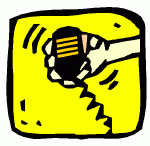 Here’s a reminder that the ARRL June VHF QSO Party (AKA The June Contest) is coming up next weekend. This is a great opportunity to have fun operating the VHF and higher bands.
Here’s a reminder that the ARRL June VHF QSO Party (AKA The June Contest) is coming up next weekend. This is a great opportunity to have fun operating the VHF and higher bands.
Here’s some info I sent out to our local club (sorry, it is a little specific to our area but you may find it useful anyway).
The ARRL June VHF QSO Party is next weekend (June 11, 12), which is The Big One in terms of VHF events. This is the best opportunity to try out VHF contesting!
Here are some practical thoughts on how you might start:
When Should I get on the Air?
The contest runs from 1800 UTC Saturday to 0259 Monday, which translates to 1200 Noon Mountain time on Saturday to 9 PM Sunday. (By the way, you should keep your log in UTC. You can always find the correct UTC time by going here: http://time.gov/timezone.cgi?UTC/s/0/java )
You can operate any time during the contest but I’d suggest focusing on noon to 6 pm Mountain time on Saturday.
What if I only have FM equipment?
Many of our new Technician licensees only have a dualband FM radio, often an HT. This will limit your activity in the contest but it doesn’t count you out. My suggestion is to get on the air on Saturday afternoon and try to contact as many stations as you can on 147.555 MHz and 446.000 simplex (Stu W0STU suggested 446.100 MHz which is also fine.) Stu W0STU and Steve WG0AT will be doing a portable operation from the top of Mt Herman on Saturday afternoon and they will be active on FM. I am sure they will appreciate a contact and a bunch of the Scouts are likely to be on the air. Don’t just work Stu and Steve….talk to everyone that you can.
I will be up in the mountains west of South Park and will also be listening on FM. I will be more difficult to reach but not impossible. Take that as a challenge! (Hint: it helps if you have a yagi antenna pointed West.)
Where Should I Go?
For starters, you don’t have to go anywhere, you can operate from home. But Height Above Average Terrain matters, so you might consider finding a “high spot” to operate from. Obviously, Stu and Steve are thinking Mt Herman is an excellent spot (which it is). There are other peaks along the Rampart Range (Raspberry Mt, Sundance Mt, etc.) that are just as good. The highest spot that is easy to get to is Pikes Peak (duh) and there is a road to the top! And Mount Evans is another option, west of Denver. If you are going to be out running around doing errands on Saturday, you can operate mobile from the car. In fact, you might want to be a “rover” and make contacts from multiple grids.
What about 6 Meters?
Six meters is usually the most fun band in the June contest. Normally, things are pretty quiet on 50 MHz and you work just the locals. But then the band opens with sporadic-e propagation and you’re working Florida, Texas, Wisconsin, Washington, California, Canada….almost anywhere in North America. For this, you’ll really want a SSB radio that can operate on 50.125 MHz USB (calling frequency) and move up from there as the band gets busy. Even a modest antenna, like a simple dipole, can work on 6 Meters. So don’t think you need something fancy to get started. There may be FM activity as well, which would be on 52.525 MHz.
Set a Goal
The basic idea is to see how many stations you can work on each band. You can also set a goal such as trying to get the Worked Colorado Award ( http://rmvhf.org/Certs/Award.html ) which is achieved by working 6 different grids on any VHF/UHF band.
What Else Do I need to Do?
Read the rules, which are available here: http://www.arrl.org/june-vhf-qso-party
Make sure you know your grid. The Monument area and all of metro Denver is in DM79. Colorado Springs and Pueblo are DM78. The dividing line runs east/west roughly at Black Forest and the USAFA stadium.
Here’s some more VHF information on my web site:
How To Work A VHF Contest
Getting Started on 2-Meter SSB
So You Want to Be a Rover
And don’t forget to have fun!!!!
73, Bob K0NR
 When the topic of ham radio comes up with normal people (that is, non-hams), I usually get asked the question “Who Do You Talk To?” I always come up with some vague and lame answer like “people all over the world” that gets me by.
When the topic of ham radio comes up with normal people (that is, non-hams), I usually get asked the question “Who Do You Talk To?” I always come up with some vague and lame answer like “people all over the world” that gets me by.










